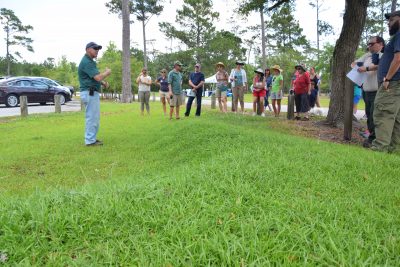
CEDAR POINT – Restoring the White Oak River watershed has been a focus since 2006, when multiple agencies, organizations and volunteers began collaborating on a study and restoration plan for a section of the river. Improvements now in place at a popular riverside recreation area provide a model for how to accomplish this goal.
The 48-mile-long White Oak River extends through Carteret, Jones and Onslow counties and has been subject to pollutants that organizations and the town have been working to address. The restoration plan was initiated to reduce runoff into Dubling Creek, Boathouse Creek, Hills Bay and the Carteret County side of the river in Cedar Point.
Supporter Spotlight
Partners in the effort highlighted the measures taken to mitigate stormwater runoff, which was impairing the river’s water quality, during the White Oak River Stormwater Solutions Tour and Waterfront Picnic held June 2 at the Cedar Point Recreation Area in Croatan National Forest.
Rachel Bisesi, coastal education coordinator with the North Carolina Coastal Federation, a member-supported nonprofit organization that works to protect and restore coastal North Carolina, welcomed the public to the tour at the Cedar Point Recreation Area, on a salt marsh near the mouth of the river.

“We wanted to invite you out here to learn a little bit more about how the federation has been working with several community partners, including the town of Cedar Point, Croatan National Forest, and ECU, or East Carolina University, to restore water quality in the White River,” she said.
When the effort began more than 10 years ago, the federation worked with partners to study what was impairing the river’s water quality. They found the No. 1 culprit was stormwater runoff. When water from heavy rains and storms hits hard and impervious surfaces such as roads, roofs, parking lots and driveways, it picks up bacteria and other pollutants as it drains into coastal waters.
To combat that issue, Bisesi explained, the federation and its partners worked together to create a watershed restoration plan that “promotes some simple, best management practices that mimic the natural hydrology of this area so that rainwater can soak into the ground and infiltrate instead of having a chance to become polluted stormwater runoff.”
Supporter Spotlight
Bree Tillet, coastal specialist with the federation, and Charles Humphrey, associate professor at East Carolina University, were also on hand to lead the tour of the recently installed projects at the recreation area.
Tillett began the tour by showing how a drainage swale that was already installed at the site was retrofitted. Earthen berms were added to slow down stormwater runoff, giving the water a chance to soak into the ground rather flowing directly across the pavement into nearby Boathouse Creek.

“While the swale is much better than a concrete pipe or concrete ditch, the Coastal Federation saw the opportunity to add in a simple retrofit that would help infiltrate the water even better. … It’s a very simple retrofit that does wonders for helping get the water in the ground instead of carrying it straight into our creek,” she said.
Humphrey then led the crowd of about 20 to view the nearby rain garden adjacent to the parking lot, and across from the boat ramp.
“The goal of our project was to reduce runoff with the idea being that if we could reduce runoff, we are going to improve water quality because it’s the runoff that’s really transporting the pollutants,” Humphrey said. Among those pollutants is wildlife waste on the impervious surfaces. “One way to reduce runoff is to retain that water.”
The rain garden was built with that goal in mind. The soil there is sandy, which makes it possible for water to sink in quickly. There are limitations, however, with the rain garden so close to sea level. This means the rain garden could not be excavated too deeply because the bottom would be too close to the water table. So, a berm was created to keep water from flowing directly into the creek. The rain garden was shaped and designed to store a one-year, 24-hour event, or about four inches, Humphrey said.
Humphrey also showed the improvements made to encourage rainwater flow into forest areas on the back of the parking lot. The road is crowned with its highest point in the center, but the previous walkway adjoining the parking lot was sloped in a way that caused water to pond in the parking lot and drain toward the boat ramp. The sidewalk was rebuilt at a grade that allowed water coming off the parking lot to drain into the forest area.

Another measure taken, Humphrey explained, was to add check dams to the drainage ditch that runs alongside the entrance road, an ancient technique recreated here with riprap, or larger rocks, to slow down the water flow into the creek.
Other projects to protect the watershed include three water-control structures in Ocean Spray Mobile Home Estates, just east of the recreation area.
Humphrey said the Ocean Spray project was similar to that in the recreation area. The road there was also crowned, enabling water to run off on the left and right sides, however, grass had grown higher on the sides of the road, forcing all of water to run down the edge of the road and, in the few low places, emptying into the ditches.
“Where it was emptying into the ditches, it was causing erosion but it was also flooding those areas because all the water from the neighborhood wasn’t really making it into the swales,” he said.
For this project, the team took a different approach. They reshaped in about 13 places the edge of the road with an excavator and placed sod there lower than the edge of the road, allowing for water to wash off the road in more places. They also put down culverts with splashboard risers.
Rainwater Collection
The nearby Marsh Harbour subdivision off N.C. 24 also received help with stormwater runoff as part of the project. The federation and Down East Insulation of Jacksonville installed 42 rain barrels to collect rain.
A resident of the neighborhood, Jenn Conceicao, attended the tour and spoke about the effect of her four rain barrels. She said she uses the collected rain water as much as possible to water her flowers.

“It’s not only good for stormwater and protecting the wetland but it’s also really great for plants,” she said.
Linda McGowen of Emerald Isle said she learned a great deal during the tour. McGowen said she was there for two reasons, one being her concerns about a new grocery store that is being built in Emerald Isle. “Acres of maritime forest have been cleared and I hope they plan to use good stormwater practices,” she said, adding “on a personal note, we have an area in our yard that is washing gullies in rain events and I wanted to find out what I can do to make a rain garden and slow down the water progress. It will protect my yard and help benefit other areas from washing hopefully.”
Jeff Kincaid, forester recreation program manager for the Croatan National Forest, was also on hand during the tour.
Kincaid recognized the federation and ECU for their work. “Nowadays, we rely a lot on volunteers and other agencies to work together and these guys do a great job communicating. They did a great job with the project.”
Kincaid told Coastal Review Online in a follow-up email, “The project does more than help to mitigate some of the non-point source pollution associated with run off and parking areas. It is also a great opportunity for education of our forest visitors. The Cedar Point day use area is heavily used year-round by locals and vacationers alike. The public education, I think, is just as important as the improvements to the site. The project also shows how government agencies can effectively work together with our partners in the community to improve the environment and visitor experiences. I look forward to working with NCCF in the future on existing and new projects.”
Humphrey also provided more details about the project in an email, including funding, which came through the North Carolina Department of Environmental Quality 319 Program. The 319 program helps fund best management practices to help improve water quality in impaired watersheds, like the lower White Oak River, using approved watershed restoration plans. ECU researchers met with the federation and discussed the potential for developing and submitting a proposal to NC DEQ to implement some of the suggestions in the White Oak River Plan.
“We developed the proposal together, the proposal was approved, and we have worked together over the past two-and-a-half years to accomplish the project goals,” he said, adding that these practices will help now and in the long run because they should continue to slow runoff during storms, which will increase infiltration and improve the treatment of stormwater.
“The main goal of the project was to reduce runoff by implementing at least 12 stormwater best management practices (BMPs). We used a variety of BMPs including water control structures, check dams, a rain garden, rain barrels, reshaped ditch banks, and other drainage modifications to reduce runoff. We were able to accomplish these goals.”
Humphrey said the project would not have been possible without cooperation from the U.S. Forest Service, Cedar Point, and volunteer property owners in Ocean Spray and Marsh Harbour.








